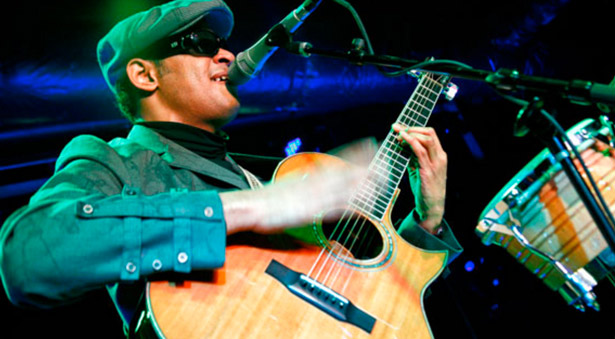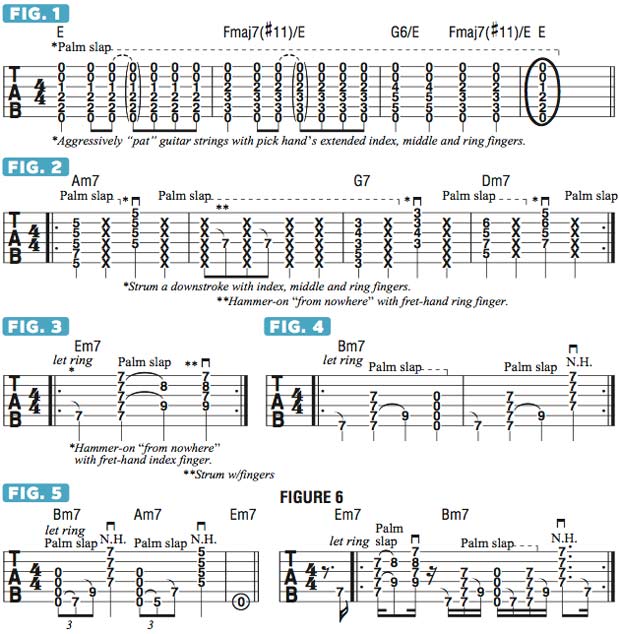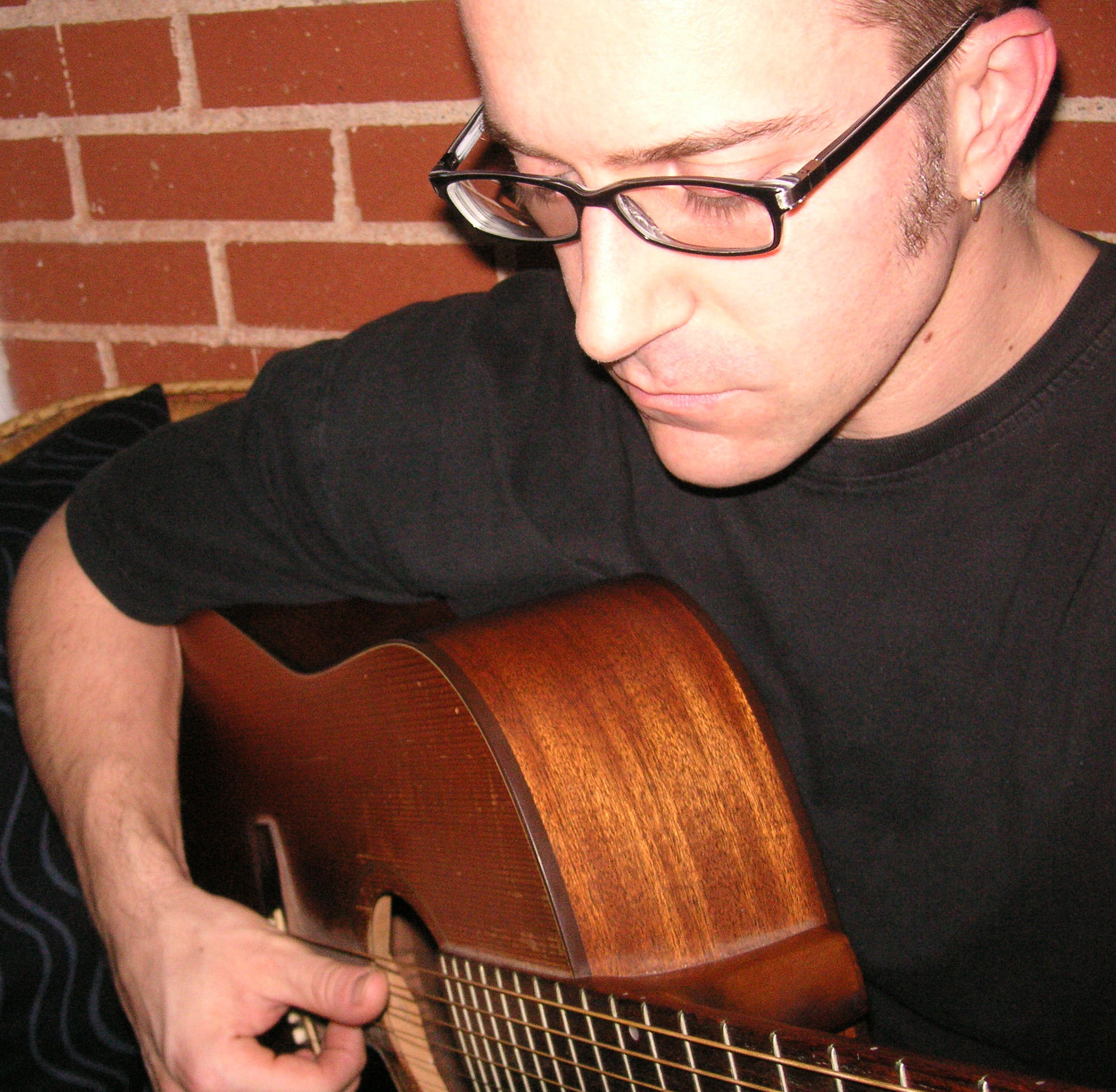The Unorthodox, Percussive-Slapping Style of Singing Guitarist Raul Midón

This past month, cyber-savvy guitarists rejoiced in yet another exciting guitar video gone viral, this one featuring blind acoustic picker Raul Midón ripping though John Coltrane’s “Giant Steps” (in all 12 keys!), playing chords beneath his trademark “mouth trumpet” one moment, and the next dropping the jaws of jazz connoisseurs with his unaccompanied single-note lines, unleashed on his Traugott Model BK ax.
Not your first visit to Raul Midón’s world? Perhaps it was this one-man band’s mind-blowing network television debut, on The Late Show with David Letterman in 2005, where his signature song, “State of Mind,” an infectious mix of percussive slaps, harmonics and quasi flamenco techniques, supporting unique vocal improvisations, brought the audience to their feet, including members of the Letterman band.
Midón, whose career began as a background singer for Shakira, Julio Iglesias and Jose Feliciano before his guitar talents became known, has since collaborated with legends Stevie Wonder, Herbie Hancock, Dianne Reeves and (on 2014’s Don’t Hesitate) Bill Withers. Let’s examine this eclectic fingerstylist’s signature techniques, which Midón serves up in songs that seamlessly meld flamenco, R&B, soul, jazz, blues, classical, folk and pop influences.
Midón first picked up a guitar at age six and grew up in a household where modern “classical” music was heard just as often as flamenco and Argentine folk. One key ingredient in Midón’s percussive guitar style points directly to these roots, a palm slap approach derived from flamenco techniques and Argentinian rhythms, where the open hand is used to rhythmically “pat” the guitar strings over the sound hole.
FIGURE 1 shows a basic example, the same “open E” voicing moved up the neck to create other sounds; Midón uses this approach almost exclusively in “Tembererana” (2007’s World Within a World). Meanwhile, FIGURE 2 adds more ingredients to the palm-slap mix—pick-hand strums intermingled with muted strings, akin to Midón’s “Invisible Chains” (from 2010’s Synthesis).
To get a grip on this groove, it’s essential that you perfect bar 1’s “Am7” quarter-note rhythm. Repeat numerous times until you’ve coordinated palm slaps on beats one (Am7), two and four (muted notes), with a finger strum of Am7’s top notes on beat three. (This same groove is used for G7 and Dm7 in bars 3 and 4.) The most complicated move lies in bar 2, where the strings are slapped in steady quarter notes while the fret-hand ring finger quickly hammers, “from nowhere”—the note is sounded by the impact of a fretting finger slamming the string into the fret—onto the fourth string on the “and” of beats one and two.
The remainder of this lesson is reserved for the “mother load” of Midón’s repertoire, the main passage in his signature song, “State of Mind.” FIGURE 3 simplifies the Em7 portion of the tune’s groove into steady quarter notes, making it easier to focus on the tricky mechanics involved: an index-finger hammer-on (again, “from nowhere”) on the fifth string (on beat one), a palm-slapped seventh-fret barre (beat two), followed by hammer-ons to Em7 (beat three) and a finger strum of the chord’s top notes (beat four).
FIGURE 4 presents similar technique combinations for Bm7, albeit with more palm slaps and a natural-harmonics strum for punctuation. FIGURE 5 features some triplet hammer-ons similar to what Midón sprinkles throughout the track. These examples are combined in FIGURE 6 and supercharged with a rhythm similar to that of Midón’s actual performance.

Get The Pick Newsletter
All the latest guitar news, interviews, lessons, reviews, deals and more, direct to your inbox!
A singer-songwriter/multi-instrumentalist/film composer, Musician's Institute instructor, and author of 50+ transcription/instructional books, Dale Turner is also Guitar World's "Hole Notes"/"Acoustic Nation" columnist, and the former West Coast Editor of Guitar One magazine. Some of Dale’s old, weird, rare, and/or exotic instruments are featured in his score for WEEDS, the first animated short completed within the Filmmakers Co-op at Disney Feature Animation. His most recent CD, Mannerisms Magnified, was praised by Guitar Player magazine for its "Smart pop tunes that are crammed with interesting guitar parts and tones ... Like what the Beach Boys might do if they were on an acid trip that was on the verge of getting out of control. Yeah!"
“There are so many sounds to be discovered when you get away from using a pick”: Jared James Nichols shows you how to add “snap, crackle and pop” to your playing with banjo rolls and string snaps
Don't let chord inversions bamboozle you. It's simply the case of shuffling the notes around








![Joe Bonamassa [left] wears a deep blue suit and polka-dotted shirt and plays his green refin Strat; the late Irish blues legend Rory Gallagher [right] screams and inflicts some punishment on his heavily worn number one Stratocaster.](https://cdn.mos.cms.futurecdn.net/cw28h7UBcTVfTLs7p7eiLe.jpg)


